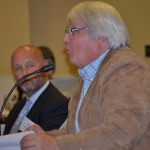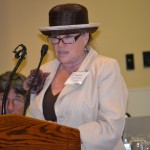California Water Commission meets in mountain counties
California Water Commission meets in mountain counties
By Roberta Long, MCWRA writer
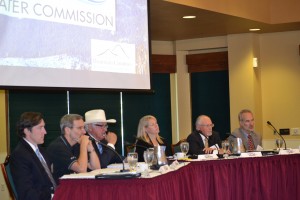 At the invitation of Mountain Counties Water Resources Association, the California Water Commission left its Sacramento hearing chamber to hold a brief business meeting followed by a workshop on small water systems on May 21 at The Ridge Events Center in Auburn. The program was sponsored by Sierra West Consultants, Inc., of Fair Oaks.
At the invitation of Mountain Counties Water Resources Association, the California Water Commission left its Sacramento hearing chamber to hold a brief business meeting followed by a workshop on small water systems on May 21 at The Ridge Events Center in Auburn. The program was sponsored by Sierra West Consultants, Inc., of Fair Oaks.
In his welcoming remarks, Mountain Counties Executive Director John Kingsbury said: “Today, you are going to hear about the challenges, programs, collaboration and opportunities from the water purveyors that are balancing a limited water supply to meet the needs of this region and of the State.
“This region is committed to statewide water solutions that protect the economy, environment and quality of life not only in the region, but in all of California.
“You will hear that:
•”We need to advance the stewardship of not only the Sierra Nevada Mountains, but all across the watersheds and headwaters in the State, both on the west slope and the east slope, as everything is linked. You pull on one end, and you will feel the tug on the other end.
•”We need to increase the water carrying capacity in the watersheds.
•”We need to increase the surface water supply and storage starting at the crest of the Sierra.
•”You will hear how this region is a leader in water conservation and water efficiency practices.
•”You will hear how this region is working to optimize recycling opportunities, and working with our valley neighbors to improve groundwater supplies.”
Seven of the eight commissioners attended the workshop. They were: Joseph Byrne, Chair, Los Angeles; Andrew Ball, San Mateo; Daniel Curtin, Sacramento; Joe Del Bosque, Vice Chair, Los Baños; Kimberley Delfino, Sacramento; David Orth, Clovis; and Luther Hintz, Brownsville. Anthony Saraceno, Sacramento, participated by teleconference.
This was not the first time the California Water Commission took its meeting on the road.
A similar meeting and workshop was held in San Diego in March.
Chairman Byrne introduced himself by saying that although he resides in southern California, he claims a connection to the mountain counties. One of his forebears lived in Mud Flat, now the town of El Dorado, in El Dorado County.
The California Water Commission
The California Water Commission was established as the State Water Resources Board in 1945. The name was changed in 1956, and its powers were detailed in California Water Code. Commission appointments expired in the 2000s, and the Commission was left vacant. In 2010, Gov. Schwarzenegger appointed nine members to the commission. The full commission met for the first time in January 2011, and continues to hold regular monthly meetings on the third Wednesday, normally in Sacramento.
The newly constituted commission was given new responsibilities. Among them are: providing a public forum for discussing water issues, approving rules and regulations of the Department of Water Resources, conducting an annual review of the State Water Project to report to the Legislature, and selecting water storage projects for funding under the Safe, Clean and Reliable Drinking Water Act if and when it passes. The commission is following the directives of the California Action Plan.
Del Bosque said the commission has been involved in promoting efficiency through agricultural measurements for volumetric pricing and the 20/20 conservation measure for municipal districts. The commission is also working with the Delta Stewardship Council.
“We are here because we want to educate ourselves about the whole state,” he said.
Delfino remarked that the mountain counties are in the forefront of climate change.
Mountain Counties regional overlay area background and interest
Mountain Counties Water Resources Association
Kingsbury said the Mountain Counties Association represents the water interests of members from all or a portion of 15 of the state’s 58 counties, from the southern tip of Lassen County to Fresno. The area includes 10 major watersheds and 13 major rivers. The watersheds account for about a quarter of all natural runoff in California, averaging 17 million acre-feet, and over half of all snowmelt runoff in the state. The runoff is an important source of groundwater recharge into the valley floor aquifers. Forty percent of the state’s developed water supply originates in this area. Dedicated in-stream flow releases at designated dams are designed to meet beneficial uses for the environment, agriculture and urban needs. Major reservoirs provide hydroelectric power and flood protection.
Rural County Representatives of California
Nick Konovaloff, legislative analyst for RCRC, said that 50-75 percent of lands in the 33 RCRC counties are publicly owned. In Inyo County, it is 98 percent, he said.
He described the major challenge to water management in the rural counties: There are no economies of scale to pay for maintenance, repair and new facilities to manage water. He added that requirements of Proposition 218 add to the difficulties.
Konovaloff addressed RCRC’s response to the California Water Action Plan, which the California Water Commission is directed to follow. He said RCRC’s critique of the plan is that it is “lacking in the need to prioritize the restoration of forests and headwaters in order to increase California’s water supply.”
The Sierra Nevada Conservancy is a nonprofit, non-regulatory organization that functions under the California Natural Resources Agency. It was established in 2004 with the passage of AB 2600, spearheaded by Gov. Arnold Schwarzenegger and co-sponsored by Assemblymembers John Laird and Tim Leslie. The Conservancy covers nearly 25 million acres in all or part of 22 counties. It maintains offices in Auburn, Bishop, Mariposa and Susanville. The 13-member board includes Natural Resources Agency Secretary John Laird and El Dorado County Supervisor Ron Briggs, who represents the Central Subregion. Funding for the Conservancy comes from Proposition 184, passed in 2006, and the California Environmental License Plate Fund.
Policy and Programs Analyst Nic Enstice said the goal of the Sierra Nevada Conservancy is to improve the economic, environmental and social well-being of California. Enstice described some of the Conservancy’s programs. Several address the forest-water management connection.
The Sierra Nevada Conservancy’s Proposition 84 Grant Program has awarded over $52 million for some 300 projects that support efforts to reduce the risk of large damaging wildfires that devastate forests, threaten communities, destroy habitat, and impair the ability of the watersheds to sustainably produce supplies of water. These projects include creating jobs in local communities.
The Sierra Nevada Forest and Community Initiative is a collaborative approach to restoring forest health and local communities’ economic health. The Great Sierra River Cleanup, an annual volunteer event, has removed 600 tons of trash and recyclables from the Sierra Nevada waterways in five years. This year the Cleanup is scheduled for Sept. 20.
The Sierra Nevada Conservancy supports tourism and recreation in the 25 million acres of the region. The Sierra Nevada GeoTourism MapGuide is available online, in print or by mobile app.
The upper Mokelumne River watershed supplies drinking water to 1.3 Bay area residents.
The Mokelumne Watershed Avoided Cost Analysis looked at the question of whether it makes economic sense to increase investment in proactive forest management to reduce the risk of large wildfires. The Sierra Nevada Conservancy is a responsible agency engaged in assisting the development of community scale forest bioenergy facilities. The challenge is to reduce the fuel loads in the forests by using the biomass to provide energy on a scale that is economical.
In March, the Conservancy board adopted a joint resolution recognizing the important connection between the Sierra and the Delta, and agreeing to address policies that impact both regions.
Sierra Business Council President Steve Frisch said the Council is composed mainly of 4,000 small and mid-sized businesses. Its focus is on landscape conservation, sustainable management, community development and leadership development.
Frisch said Californians need a broader definition of water storage. The snowpack holds more water than the reservoirs, he said. He recommended increasing investment in science in the Sierra Nevada, using a pilot project approach.
He announced the Sierra Business Council will be holding a three-day Peak Innovation Conference Oct. 8-10 at North Lake Tahoe, where they will be celebrating the 20th anniversary of the Council, and looking forward to the next 20 years.
Challenges facing disadvantaged communities
 Historical Sierra Nevada perspective–Placer County Water Agency
Historical Sierra Nevada perspective–Placer County Water Agency
Geologist and soil scientist Marie Davis, who works with Placer County Water Agency, introduced the character of the Sierra Nevada lands. She talked about the need to build adaptive capacity at the source.
Davis compared the headwater systems to circulatory systems, with creeks, streams and soil moisture as the capillaries that flow into the arterial rivers. These waters replenish Central Valley groundwater, supply water for California’s needs, and flow into the ocean to be returned to the watersheds. The forests act as conduits.
She talked about the role of the soils in water storage, and the danger of high intensity wildfires. In August of last summer there was a wildfire on the middle fork of the American River. It burned more than 27,000 acres over 17 days before it was contained. The summer before, the Robbers Fire burned 2,600 acres over nine days near the community of Foresthill. Davis said fires of that intensity sterilize the soils, which form a crust. It takes thousands of years for the soils to recover, she said.
Best Management Practices– El Dorado Irrigation District
Saying that “Mountain Counties water agencies are leaders, not laggards,” El Dorado Irrigation District (EID) General Counsel Tom Cumpston used his district as an example.
From 1925, the year it was formed, the district began implementing water conservation measures. The first measure was to line the miles of dirt ditches built by miners that carried water to local homes, farms and businesses. In 1970 EID was the first irrigation district to adopt a water conservation plan. In 1977 EID began Irrigation Management Service, providing soil-moisture readings, California Irrigation Management Information System data, and computerized, site-specific watering schedules, saving 2,000 acre-feet per year. In 1980 the district adopted a 100 percent metering policy. During the 1980s and 1990s, with grant assistance, the district implemented the first residential water audit, a leak detection program, the first low-flow toilet rebate program, and inclining-block conservation pricing.
Efforts continued in the 2000s, and the district was recognized with state and national water conservation awards.
Perhaps the innovation EID is most noted for is the dual-pipe residential program that was instituted in El Dorado Hills. In a partnership with the developer of a specific plan, about 4,000 units are dual-plumbed, with recycled water used for all front and backyard irrigation. With drought-resistant landscaping, the savings of potable water is around 2,500 acre-feet a year.
Cumpston said EID’s conservation savings provide regional and statewide benefits, but funding assistance is essential.
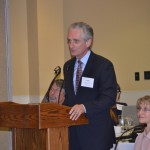 Water rights challenges– El Dorado Irrigation District
Water rights challenges– El Dorado Irrigation District
Cumpston said, like many Mountain Counties water districts, EID’s historical water rights extend back to the 1850s through the 1920s. However, documenting continuous beneficial use through the economic changes from mining to agriculture to modern demands is challenging. EID now provides a population of about 100,000 people within a 220-mile service area in western El Dorado County with treated water, wastewater disposal, recycled water and recreation services. The district is entirely dependent on surface water. Operations and management of infrastructure more than 160 years old, especially in winter at high elevations, is a monumental challenge. Modernizing projects pose environmental challenges.
EID successfully fended off a threat to senior water rights when the State Water Resources Control Board applied Term 91 as a condition of exercising those rights. The result of applying Term 91 would have reduced those rights to junior status. Judge Robie upheld the trial court’s ruling in favor of EID in 2006.
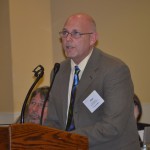 Operational challenges– Amador Water Agency
Operational challenges– Amador Water Agency
Amador Water Agency General Manager Gene Mancebo said the agency serves around 10,000 customers. The county is losing population. Between 2010 and 2013, the county lost 4.1 percent, while the state gained 2.9 percent. Amador has an average of one person per square mile versus 2,420 in the Los Angeles and 1,471 in Sacramento. Thirty-seven percent of the residents are 55 or over. Unemployment is high and wages are low. Rates are high and rate increases are protested.
Outdated facilities create problems for water quantity and quality. Leaks, erosion, and breaks
have to be repaired in summer temperatures of over 100 degrees, and in winter when snowshoes provide the only access.
In spite of the difficulties, the agency is being proactive. With the financial assistance of the U.S. Department of Agriculture, and a bridge loan from Amador County, the agency is in the process of installing a 6.6-mile gravity-fed pipeline that will deliver Mokelumne River water from its Tiger Creek Regulator Reservoir. The Gravity Supply Line will replace an aging pumped raw water delivery system. The reduced operating costs and power-related water interruptions in the upcountry will conserve water and money and improve fire protection.
Another project is the Amador-Calaveras Groundwater Basin Recharge. It is an integrated regional conjunctive use project with East Bay Municipal Utility District (EBMUD). The benefits are an increase in a reliable water supply for Amador and Calaveras, groundwater basin recharge and sustainability for San Joaquin, and drought protection for EBMUD. In addition, the project provides opportunities to settle Mokelumne River water rights protests.
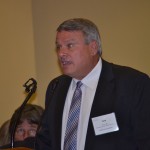 Funding challenges–Calaveras County Water District
Funding challenges–Calaveras County Water District
Calaveras County Water District Board Director Don Stump said the district was formed as a county water district in 1946. Its service area covers 1,100 square miles with 44,000 people. The water district serves around 15,000 customers.
Stump said the base bi-monthly water rate is $100, and is moving to $125. “We have maxed out our ability to go to ratepayers,” he said.
He said Calaveras’s system was not designed for water storage. The district is studying 23 small projects all across the service area. “Three have serious potential,” he said. Meadow restoration may offer some additional opportunities.
“We are already experiencing climate change,” Stump said. “More water will be coming as rain.”
The Mokelumne, Calaveras and Stanislaus rivers all flow into the Delta, where all the water ends below. “Control is out of our hands,” he said. “We believe in beneficiary pays. We can’t be good stewards without funding.”
Placer County Supervisors Jennifer Montgomery represents District 5, the largest district in Placer County. It stretches from the city of Auburn to Lake Tahoe. A major part of eastern Placer County is federally managed.
Montgomery said she lives near Donner Summit, at 7,000 feet elevation. She said Tahoe businesses took a big hit this winter. With the exception of a few storms, the ski resorts did the best they could with manufactured snow from snow machines. But the perception of no snow discouraged winter visitors and all businesses were affected. This affects the county too, she said.
Low water is also affecting the summer tourist season. Montgomery said that in Tahoe City the rafting companies that go on the Truckee River are down to a three-week season. In the lower elevations, the agriculture industry is being affected.
Montgomery said, “The biggest bang for the buck is to concentrate on where the water comes from. That’s where you’ll get the biggest return on investment.” There are opportunities for watershed management and investments in soft infrastructure. “The science is there, “she said. “We need a couple more years to ‘true it up.’”
She talked about Placer County’s Forest Biomass Reduction and Wildfire Treatments project on the east side of the Sierra Nevada between Truckee and Squaw Valley. It uses forest waste products that would otherwise be burned, keeping the air cleaner and creating energy from waste. A 2.1 MW plant will provide five jobs. Montgomery said the project is “cheaper than forest fires.”
Regional project opportunities
Five water districts and agencies presented representative projects and actions that are either proposed or underway. At the end of the day, Mountain Counties President Don Stump summarized the messages from the workshop.
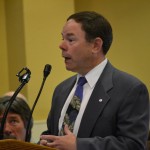 Nevada Irrigation District–Storage Recovery Project
Nevada Irrigation District–Storage Recovery Project
Nevada Irrigation District (NID) has 5,560 customers in an area that covers 287,000 acres east and west of Highway 49 from north of Auburn to north of Nevada City. General Manager Rem Scherzinger said the district’s waters are snow-driven. Snow surveys taken April 30 measured 16 percent of average water content in the mountain snowpack that supplies the system. We are experiencing a changing climate, he said. There will be very little carryover for the next winter if the dry weather continues.
Nevada Irrigation District’s reservoirs are in an area that was heavily mined. Sediment has been building up in the reservoirs, reducing storage capacity. The sediment contains mercury residue from the mines. NID owns the only mercury-removing machine in the state. The machine will be put into operation this summer at Combie Lake Reservoir. NID is working with the State Water Resources Control Board to return lost storage to impacted dams. The recovery at Lake Combie provides clean aggregate. Scherzinger said there is market potential from gold and other elements in the sediment. He said NID is running out of water and has to diversify its portfolio.
 Placer County Water Agency-Northern California water reliability
Placer County Water Agency-Northern California water reliability
Andy Fecko, director of resource development for Placer County Water Agency (PCWA), explained PCWA’s position on the effects of current conditions in Placer and El Dorado counties, where the American River basin is located. He said that PCWA believes Placer and El Dorado county water resources are threatened by the operation of federal facilities, particularly federal reservoirs that serve their regions.
He specifically mentioned Folsom reservoir, which was completed in 1956 primarily as a flood control project. The reservoir collects waters from the three forks of the American River, and can hold almost one million acre-feet of water. However, due to the combination of an extended drought and increasing regulatory demands for water for endangered fish species and Delta water quality standards, the water levels periodically fall dangerously low.
Recently, water levels almost fell below the intake pipes that carry water to customers in the San Juan Water District, the City of Roseville and the City of Folsom.
He pointed out that Folsom Lake, as the closest large reservoir in the Central Valley Project system, is the first responder to an emergency in the Delta. Extremely low water levels impair the ability to respond.
Fecko said the statewide water plan should include an operational plan for the region’s reservoirs and rivers that takes into account the changing climate and maintains enough water in storage to prepare for drought years.
He said the local American River basin purveyors realize they can no longer rely solely on Folsom Lake to meet the region’s water needs. Investments in new facilities and joint programs are required. PCWA and other purveyors are taking steps to diversify water supplies and enhance reliability through conservation actions and infrastructure projects.
In an email addendum following the workshop, Fecko addressed the expected effects of the $962 million auxiliary spillway being constructed at Folsom Dam. The spillway is a joint project between the U.S. Army Corps of Engineers and the U.S. Bureau of Reclamation to provide the Sacramento region with 200-year level of flood protection.
Fecko said: “The flood control infrastructure upgrade, along with better hydrology and weather forecasting, should allow increased water storage in the fall and through the winter. It is important that this be codified in an updated Folsom operating plan. In our view, the Folsom upgrades are not yet complete. A new temperature control device to allow finer control of release temperatures to benefit salmon and steelhead is still needed as well as an extension of the power intakes to allow access to the very bottom of the reservoir without bypassing power production. Both of these upgrades ought to be completed as soon as possible.”
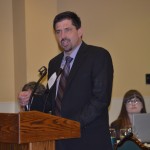 Foresthill Public Utility District–Sugar Pine Dam Raise
Foresthill Public Utility District–Sugar Pine Dam Raise
Foresthill is 60 miles northeast of Sacramento, in Placer County. The water district serves around 2,000 customers, mostly residential. The district’s sole reservoir, Sugar Pine, is within the Tahoe National Forest at 3,600 feet elevation.
General Manager Hank White said that Sugar Pine Dam was designed to hold 10,000 acre-feet. Construction was finished in 1981 with two spillway openings, and although the hydraulic cylinders to fit radial arms were attached to the walls, the radial arms were not installed at the time. The reservoir capacity was 7,000 acre-feet. White said the district believes now is the time to finish the project. By controlling water flows with the radial arms, the reservoir could hold an additional 3,000 acre-feet.
White said the small project would have large benefits, not only for the district, but also the region. He enumerated the merits: drought–increases storage; population growth–prepares region for growth; climate change–captures water when it is available; declining fish habitat–enhances fishery and improves ecosystem resources; poor flood protection–provides additional flood protection to 7 million residents in flood plains; supply disruptions–regional resource management; poor water quality–impounds the highest quality water; timeline–shovel ready.
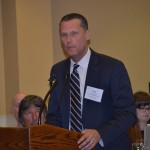 El Dorado County Water Agency–The Watershed Connection
El Dorado County Water Agency–The Watershed Connection
“The Rim Fire was a game-changer,” said General Manager Dave Eggerton. “The conditions that caused that catastrophic wildfire are evident all throughout the Sierra Nevada and threaten our headwaters. This affects all Californians.”
He emphasized projections that point to a 60 percent loss of snowpack by 2050, and said
he supports the Water Action Plan’s call to make investments in the water supply from the Sierra Nevada a high priority.
Eggerton referred to the Policy Principles for Improved Management of California’s Headwaters, adopted by the Association of California Water Agencies in March 2013, as articulating a comprehensive solution.
He said the El Dorado County Water Agency is working with the Delta Stewardship Council to link with the Council’s science program and bring options and tools to the upper watersheds.
Eggerton said there are connections between the upper watersheds and downstream groundwater areas. “There are incredible needs and opportunities to protect existing water supplies,” he said. Banking water downstream is one approach. It will replenish drained basins and store water for the future.
One of the agency’s responsibilities is to secure water rights for El Dorado County. Eggerton said: “For the last several years, we have worked hard to redesign our water rights application to the State Water Resources Control Board for 40,000 acre-feet of water storage in Sacramento Municipal Utility Districts Upper American River reservoirs. We are doing it in a way that meets our local economic and environmental needs while advancing important policy goals of the state and our region such as groundwater banking, drought protection, water use efficiency, ecosystem enhancement, and local water supply reliability today and for the future.”
 South Tahoe Public Utility District–The Northern Nevada Connection
South Tahoe Public Utility District–The Northern Nevada Connection
Assistant General Manager Paul Sciuto said the Tahoe region has several water districts around Lake Tahoe and in the two states of California and Nevada. The Truckee River supplies about 75 percent of the water supply for Reno-Sparks. In California, the Truckee River basin includes the communities of Tahoe City, Alpine Meadows, Squaw Valley and Truckee. Much of it is within the Tahoe and Toiyabe National Forests.
The east and west forks of the Carson River originate in Alpine County, south of Lake Tahoe, and join the Carson River in Genoa, Nevada. Most of the Carson River watershed is in public lands and includes lands of the Washoe Tribe in California and Nevada.
South Tahoe District encompasses 27,000 acres along the south shore of Lake Tahoe from the Nevada state line west to include Emerald Bay. The district is totally dependent on groundwater wells for its water supply. Annual production is nearly 2.5 billion gallons from 16 groundwater wells, which is stored in 22 tanks. More than 13,900 homes and businesses are served through 253 miles of waterlines.
California’s Porter Cologne Water Quality Control Act, which passed in 1969, mandates that all effluent must be transported outside the Tahoe Basin. South Tahoe has three treated effluent pipelines out of the basin and one raw wastewater pipe. With 17,800 wastewater customers, the district exports about 1.6 billion gallons of treated effluent a year. The recycled water is pumped to Alpine County and to Nevada, where it is used for irrigation. The district is allowed an exception to use recycled water for fire.
Sciuto said the snowpack was 20 percent of normal this past winter. If there is any good news, it is that the beaches will be much bigger this summer, he said.
South Tahoe is one of 16 parties who signed the Truckee River Operating Agreement in September 2008. This landmark agreement followed decades of fighting and litigation. Sciuto itemized benefits of the agreement: 1) increases the operational flexibility and efficiency of reservoirs; 2) provides additional opportunities to store water in existing reservoirs; 3) enhances spawning flows and fish habitat; 4) increases recreational opportunities; 5) improves water quality in the Truckee River.
Water rights on the Carson River were clarified by a federal court decree entered in October 1980. The decree had been initiated in 1925, 55 years earlier. The decree establishes the rights to reservoir storage in the high alpine reservoirs.
Sciuto said the Tahoe area was traumatized by the Angora Fire in 2007. As a result, the district is replacing undersized pipes and upgrading pumps and other facilities to be better prepared for a fire event in the future. He said the water and fire agencies are building links to coordinate firefighting efforts.
Mountain Counties Water Resources Association–The Statewide Connection
Mountain Counties President Don Stump told the Commission, “We would like you guys to be our new best friends. We’re pretty sophisticated. We work closely with each other and with others in the region. We’ve done a whole lot with very little.”
Next steps
Commissioner Del Bosque told the audience, “This workshop has been enlightening. We got more information here than if we had been in Sacramento. I’m interested in hearing more.”
Commissioner Curtin reiterated Del Bosque’s remarks. “I’m incredibly impressed and informed,” he said.
Curtin made a motion that was unanimously passed to direct staff to investigate the possibility of a joint meeting with a Commission regarding forestry and water issues.
Mountain Counties response
Following the meeting, Mountain Counties Executive Director John Kingsbury said, “I very much appreciate the Commission’s interest in this region and I look forward to working with the commissioners and their staff to advance this region’s water supply interests and those of the state.”
Jeffrey Bensch, principal engineer with Sierra West Consultants, sponsor of the workshop, said, “Sierra West recently joined Mountain Counties after attending a number of uniquely informative and timely events related to the region’s water supply needs. We appreciate the opportunity to underwrite an event that supports Mountain Counties and applies to small water systems that are often overshadowed by concerns of the larger water agencies in California.”


